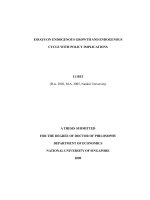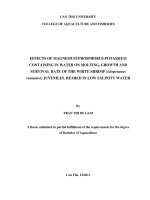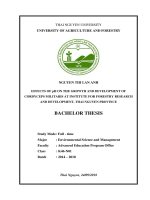Influence of different plant spacings on vegetative growth and yield of red cabbage (Brassica oleracea var. capitata f. rubra) - TRƯỜNG CÁN BỘ QUẢN LÝ GIÁO DỤC THÀNH PHỐ HỒ CHÍ MINH
Bạn đang xem bản rút gọn của tài liệu. Xem và tải ngay bản đầy đủ của tài liệu tại đây (175 KB, 6 trang )
<span class='text_page_counter'>(1)</span><div class='page_container' data-page=1>
<i><b>Int.J.Curr.Microbiol.App.Sci </b></i><b>(2017)</b><i><b> 6</b></i><b>(11): 1695-1700 </b>
1695
<b>Original Research Article </b>
<b>Influence of Different Plant Spacings on Vegetative Growth and Yield of </b>
<b>Red Cabbage (</b>
<i><b>Brassica oleracea</b></i>
<b> var. </b>
<i><b>capitata</b></i>
<b> f. </b>
<i><b>rubra</b></i>
<b>) </b>
<b>S. Manasa*, L. Mukunda Lakshmi, Syed Sadarunnisa and T. Rajasekharam </b>
College of Horticulture, Anantharajupeta, Dr. Y.S.R. Horticultural University,
Andhra Pradesh, India
<i>*Corresponding author </i>
<i><b> </b></i> <i><b> </b></i><b>A B S T R A C T </b>
<i><b> </b></i>
<b>Introduction </b>
Red cabbage (<i>Brassica oleracea </i>var. <i>capitata </i>
f. <i>rubra</i>) is an important fancy and highly
nutritive exotic vegetable. It belongs to the
family Brassicaceae, having chromosome
number 2x=2n=18. It comes under the
subgroup <i>rubra </i> of cabbage (<i>Brassica </i>
<i>oleracea </i>var<i>. capitata </i>L.). It is a biennial but
grown as annual for its characteristic purple
or red edible heads. It is used as salad, boiled
vegetable, cooked in curries, used in pickling
as well as dehydrated vegetable. Red cabbage
is known to possess medicinal properties. It
has an anticancer property due to the presence
of indole-3-carbinol. It is a rich source of
carotene, proteins (0.35%), fats (0.25%),
minerals like calcium (3.56%), phosphorus
(19.90%), potassium, sulphur etc. and
vitamins <i>viz</i>., A, B1, B2 and C. In India, its
cultivation is negligible but now gaining
popularity with Indian growers for the last
few years due to its high nutritive value and
increased tourist influx.
In India, cabbage including red cabbage is
cultivated in an area of 388 thousand ha
producing 8755 thousand MT (Anonymous,
2015-16). In Andhra Pradesh, the crops are
cultivated in 5.43 thousand ha with a
production of 81.45 thousand tonnes. Apart
from India, red cabbage can be found
<i>International Journal of Current Microbiology and Applied Sciences </i>
<i><b>ISSN: 2319-7706</b></i><b> Volume 6 Number 11 (2017) pp. 1695-1700 </b>
Journal homepage:
A field study was conducted at AICRP on Citrus, Citrus Research Station,
Tirupati, Andhra Pradesh during the year 2017 under Dr. Y.S.R. Horticultural
University, to find out the Influence of different plant densities on vegetative
growth and yield of red cabbage (<i>Brassica oleracea</i> var. <i>capitata</i> f. <i>rubra</i>) cv. Red
Jewel. Three different spacings were taken <i>viz., </i>45x45 cm, 60x45 cm and 60x60
cm. The experimental variables measured were vegetative characters (plant height,
plant spread and number of leaves at 30, 60 DAT and at harvest along with
number of days for head initiation and harvest) and yield (yield per plot and
marketable yield). Plant spread, number of leaves, days for head initiation and
days to harvest generally increased as the plant spacing increased, whereas, plant
height, yield per plot and marketable yield were increased with a decrease in plant
spacing.
<b>K e y w o r d s </b>
Red cabbage, Spacing,
Growth, Yield.
<i><b>Accepted: </b></i>
15 September 2017
<i><b>Available Online:</b></i>
10 November 2017
</div>
<span class='text_page_counter'>(2)</span><div class='page_container' data-page=2>
<i><b>Int.J.Curr.Microbiol.App.Sci </b></i><b>(2017)</b><i><b> 6</b></i><b>(11): 1695-1700 </b>
1696
throughout Northern Europe, America, and
parts of China. Since this crop has been
introduced recently in Andhra Pradesh, there
is a need to standardize the package of
practices to suit the local conditions. Among
various factors that contribute towards the
attainment of potential yield in red cabbage,
spacing is of prime consideration.
Maintenance of optimum plant population per
unit area plays an important role on yield. Too
high or too low plant densities per unit area
reduce the crop yields. In recent years, there
has been a growing interest in the use of
narrow rows as well as narrow plant spacing
for the production of cabbage. By changing
inter and intra row spacings, several workers
reported higher yield in crops like broccoli
(Agarkar <i>et al., </i>2010), tomato (Singh, 2004)
and cabbage (Mahesh Kumar and Rawat,
2002).
In spite of its greater importance in terms of
returns, no systematic research work has been
carried out to standardize the suitable
agro-techniques for successful cultivation of red
cabbage in Andhra Pradesh.
Therefore, it is essential to find out the
optimum plant densities for vegetative growth
and yield maximization of red cabbage
(<i>Brassica oleracea </i>var. <i>capitata </i>f. <i>rubra</i>) in
Andhra Pradesh.
<b>Materials and Methods </b>
The present investigation entitled “Influence
of different plant spacings on vegetative
growth and yield of red cabbage (<i>Brassica </i>
<i>oleracea</i> var. <i>capitata</i> f. <i>rubra</i>)” was executed
at AICRP on Citrus, Citrus Research Station,
Tirupati, Andhra Pradesh during <i>rabi</i>, 2017
under Dr. YSR Horticultural University. The
experiment was laid out in a factorial
randomized block design with three
replications. The experiment was carried out
with the variety Red Jewel. The experimental
area was divided into plots of 3.5 m x 3.5 m
size. Red cabbage seedlings were transplanted
at a spacing of 45 x 45cm, 60 x 45 cm and 60
× 60 cm as per the treatments. To raise the
crop recommended package of practices were
followed. The various parameters were
recorded from five randomly selected tagged
plants <i>viz</i>., plant height, plant spread, number
of leaves, days taken for head initiation, days
to harvest, yield per plot and marketable
yield. The data was subjected to statistical
analysis as per method suggested by Panse
and Sukhatme (1967).
<b>Results and Discussion </b>
The results obtained from the present
investigation as well as relevant discussion
have been summarized under following
heads:
<b>Plant height </b>
The result of the experiment revealed
significant difference among treatments with
regard to plant height at 30, 60 DAT and at
harvest. At 30, 60 DAT and at final harvest,
the tallest plants (19.62, 24.52 and 30.69 cm,
respectively) were recorded at closer spacing
(45 x 45cm) followed by medium spacing
(18.00,22.71 and 30.05 cm, respectively)
while the shortest plants (17.80, 20.05 and
28.75 cm, respectively) were found from
wider spacing (60 × 60 cm) (Table 1).
It was observed that maximum plant height
was recorded with the closer plant spacing of
45 x 45cm at different sampling occasions.
Increased plant density coupled with shallow
root system limits the availability of space for
lateral growth.
</div>
<span class='text_page_counter'>(3)</span><div class='page_container' data-page=3>
<i><b>Int.J.Curr.Microbiol.App.Sci </b></i><b>(2017)</b><i><b> 6</b></i><b>(11): 1695-1700 </b>
1697
radish, Khurana <i>et al.,</i> (1990) in cauliflower
and Hill (2000) in Chinese cabbage.
<b>Leaf number per plant </b>
Data in Table 1 revealed that the wider the
plant spacing the higher was the leaf number.
Maximum number of leaves per plant at 30,
60 DAT and at final harvest (19.56, 26.51 and
33.10, respectively) was obtained at the
widest spacing of 60 cm × 60 cm and
minimum number of leaves per plant (16.43,
23.94 and 30.09, respectively) was found at
the lowest spacing of 45 × 45 cm. This might
be due to lesser competition for nutrients and
light amongst the plants with lower plant
density. Hence in wider spacing due to the
availability of more space and light, the crop
might have produced more number of leaves
per plant. These results were in conformity
with the results of Hill (2000) in Chinese
cabbage, Singh (2005) in cauliflower and
Agarkar <i>et al.,</i> (2010) in broccoli.
<b>Plant spread </b>
Effect of plant spacing on spread of plant was
found to be significant at different DAT (at
30, 60 DAT and at harvest). Maximum spread
of plant at 30, 60 DAT and at harvest (22.70,
51.85 and 66.46 cm, respectively) was
obtained from 60 cm × 60 cm followed by 60
× 45 cm and the lowest (18.62, 44.18 and
51.95 cm, respectively) from 45 × 45 cm.
These results can be attributed to fact that, in
wider spacing the individual plant gets plenty
of light and more nutrients in comparison to
closer spacing. The results of present findings
were in agreement with the findings of
Sharma and Chaudhary (1996) in cauliflower
and Purushottam (2001) in cabbage.
<b>Number of days for head initiation </b>
Number of days from transplanting to head
initiation was not significantly varied among
different plant densities. However, wider
spaced plants required maximum days for
head initiation (50.44) whereas minimum
number of days (47.73) for closer spaced
plants. Higher photosynthesis and dry matter
assimilation due to higher number of leaves
coupled with higher availability of nutrients
leads to vegetative growth for longer period
and as such the reproductive phase was
delayed. Similar results were reported by
Sharma <i>et al., </i>(1995) in broccoli, Sharma and
Koul (2004) in leek and Chatterjee (2006) in
cauliflower.
<b>Table.1 Effect of different plant spacings on plant height, number of leaves and plant spread in </b>
red cabbage
<b>Treatments </b> <b>Plant height (cm) </b> <b>Number of leaves </b> <b>Plant spread </b>
30
DAT
60
DAT
At
harvest
30
DAT
60
DAT
At
harvest
30
DAT
60
DAT
</div>
<span class='text_page_counter'>(4)</span><div class='page_container' data-page=4>
<i><b>Int.J.Curr.Microbiol.App.Sci </b></i><b>(2017)</b><i><b> 6</b></i><b>(11): 1695-1700 </b>
1698
<b>Table.2 Effect of plant spacings on days for head initiation, days to harvest, yield per plot and </b>
marketable yield in red cabbage
<b>Treatments </b> <b>Days for head </b>
<b>initiation </b>
<b>Days to harvest </b> <b>Yield per plot </b> <b>Marketable </b>
<b>yield </b>
45 × 45 cm 47.73 82.55 23.80 183.69
60 × 45 cm 48.55 83.33 19.87 153.29
60 × 60 cm 50.44 85.55 16.23 125.21
<b>S.Em ± </b> 0.732 0.409 0.077 0.783
<b>C.D(P=0.05) </b> N.S.* 1.227 0.232 2.350
<b>Days to harvest </b>
Number of days to harvest was significantly
influenced by different plant densities (Table
2). The treatment 45 × 45 cm took lowest
number of days to harvest (82.55), which was
statistically identical with 60 × 45 cm (83.33),
while at 60 × 60 cm (85.55) maximum
number of days were required for harvesting.
Closely spaced plants experience heavy
competition among themselves for available
nutrients which induces poor synthesis and
utilization of accumulates reduced
photosynthetic efficiency. This results in
limited vegetative growth and short vegetative
phase that leads to an early commencement of
reproductive phase. Similar results were
reported by Sharma <i>et al., </i>(1995) in broccoli,
Sharma and Koul (2004) in leek and
Chatterjee (2006) in cauliflower.
<b>Yield per plot </b>
Perusal of the data in Table 2 indicates highly
significant results for yield per plot. Planting
density of 45 x 45 cm gave the highest yield
(23.80 kg/plot) which was statistically similar
to medium plant density (19.87kg/plot). The
lowest yield (16.23 kg/plot) was recorded
with lower plant density. The maximum yield
per plot was found superior at higher plant
density which was possibly due to more
number of plants per unit area; higher ground
covers of leaf area resulted in higher light
interception and hence, higher assimilate
production. Similar results have been reported
by Sharma and Chaudhary (1996) in
cauliflower and Agarwal <i>et al., </i> (2007) in
broccoli.
<b>Marketable yield </b>
Marketable yield of red cabbage was
significantly influenced by the plant spacing.
The maximum marketable yield (183.69 q/ha)
was obtained from the spacing of 45 × 45 cm
followed by the medium plant density (153.29
q/ha) while, minimum yield (125.21 q/ha)
was recorded with lower plant density.
</div>
<span class='text_page_counter'>(5)</span><div class='page_container' data-page=5>
<i><b>Int.J.Curr.Microbiol.App.Sci </b></i><b>(2017)</b><i><b> 6</b></i><b>(11): 1695-1700 </b>
1699
q/ha), respectively. Similar results have been
reported by Agarwal <i>et al., </i>(2007) in broccoli.
The study was conducted to investigate the
best plant spacing for highest yield. The
spacing used in the study showed significant
variation among the different treatment. From
the investigation it can be concluded that, at
30, 60 DAT and at final harvest, the tallest
plants (19.62, 24.52 and 30.69 cm,
respectively) were recorded at closer spacing
(45 x 45cm) and the shortest plants (17.80,
20.05 and 28.75 cm) were found from low
density planting (60 × 60 cm). Highest
number of leaves (19.56, 26.51 and 33.10, at
30, 60 DAT and at final harvest, respectively)
and plant spread (22.70, 51.85 and 66.46 cm,
at 30, 60 DAT and at final harvest,
respectively) were noticed at 60 × 60 cm and
the lowest were recorded at 45 × 45 cm. High
density plants took less number of days for
both head initiation and days to harvest. But,
highest yield per plot (23.80 kg) and
marketable yield (183.69 q/ha) were recorded
at high plating density (45 x 45 cm).
<b>References </b>
Agarkar, U.R, Dadmal, K.D, Nikas, N.S. and
Piwlatkar, G.K. 2010.Effect of nitrogen
levels and spacing on growth and yield
of broccoli (<i>Brassica oleracea </i> var.
<i>italica </i>L.). <i>Green Farming.</i>1(5): 477 –
479.
Agarwal, A, Gupta, S. and Ahmed, Z. 2007.
Nitrogen nutrition and plant density
influencing marketable head yield of
broccoli in cold arid desert of Ladakh.
<i>Acta Horticulture.</i>756: 299 – 307.
Anonymous, 2015-16. National Horticulture
Mission, Government of India.
Bhangre, K.K, Sonawane, P.C. and Warade,
S.D. 2011.Effect of different varieties
and spacing on growth and yield
parameters of broccoli (<i>Brassica </i>
<i>oleracea </i> L. var. <i>italica</i>) under Pune
conditions. Asian Journal of
Horticulture. 6 (1): 74-76.
Chatterjee, R. 2006. Effect of transplanting
dates and spacing on seed yield and
quality of cauliflower (<i>Brassica </i>
<i>oleracea </i>var. <i>botrytis </i>L.) cv. Pusa Early
Synthetic. <i>Seed Research.</i>34 (1): 104 –
106.
Fabek, S, Toth, N, Benko, B and Peic, I.
2011.The effect of plant density on
morphological traits and yield of
broccoli.GlasnikZastiteBilja. 34 (1):
22-29.
Hill, T.R. 2000.Effect of plant spacing and
nitrogenous fertilizers on the yield of
Chinese cabbage (<i>Brassica campestris </i>
sp<i>. </i> <i>pekinensis</i>). <i>Australian </i> <i>J. </i>
<i>Experimental Agri. </i>30 (3): 437 – 439.
Hossain, M.F, Ara, N, Uddin, M.R, Dey, S
and Islam, M.R. 2011.Effect of time of
sowing and plant spacing on broccoli
production. Tropical Agricultural
Research and Extension. 14 (4): 90-92.
Khurana, D.S, Harjit Singh, Jarnail Singh and
Cheema, D.S. 1990. Effect of N, P and
plant population on yield and its
components in cauliflower. <i>Indian </i>
<i>journal of Horticulture.</i>47 (1): 70 – 74.
Mahesh Kumar and Rawat, T.S. 2002. Effect
of nitrogen and spacing on the quality
and yield of cabbage (<i>Brassica oleracea </i>
L. var. <i>capitata). Agric. Sci. Digest. </i>22
(2): 90 – 92.
Panse, M. and Sukhatme, K. 1985.Statistical
methods for agriculture workers. <i>Indian </i>
<i>Council </i> <i>of </i> <i>Agriculture </i> <i>Research </i>
<i>Publications.</i>48-67.
Purushottam, P.K. 2001. Plant spacing: a key
husbandry practice for rainy season
cabbage production. <i>Nepal Agricultural </i>
<i>Research Journal. </i>4 & 5: 48 – 55.
Rastogi, K.B, Sharma, P.P. and Korla, B.N.
</div>
<span class='text_page_counter'>(6)</span><div class='page_container' data-page=6>
<i><b>Int.J.Curr.Microbiol.App.Sci </b></i><b>(2017)</b><i><b> 6</b></i><b>(11): 1695-1700 </b>
1700
Sharma, D.K, Chaudhary, D.R. and Raj
Narayan. 1995. Effects of dates of
planting and plant density on growth of
curd and seed yield in sprouting
broccoli (<i>Brassica oleracea </i>var<i>. italica</i>)
cv. Green Head. <i>South </i> <i>Indian </i>
<i>Horticulture.</i>43 (1- 2): 59-61.
Sharma, D.K. and Chaudhary, D.R. 1996.
Time of sowing and plant density on
growth and curd yield in early
cauliflower (<i>Brassica oleracea </i>L. var.
<i>botrytis</i>) cv. Early Kunwari. <i>Vegetable </i>
<i>Science. </i>23 (2): 141 – 144.
Sharma, D.K. and Koul, B.L. 2004. Effect of
dates of planting and spacing on growth
and yield in leek (<i>Allium porrum </i>L.) cv.
Musselburgh. <i>Vegetable Science. </i>31 (2):
199 – 200.
Singh, A.K. 2004.Effect of nitrogen and
phosphorus on growth and curd yield of
cauliflower var. Snowball- 16 under
cold arid region of Ladakh. <i>Haryana J. </i>
<i>of Horticultural Sciences.</i>33 (1/2): 127
– 129.
Singh, R.V. 2005. Response of late
cauliflower to plant spacing nitrogen
and phosphorus fertilization. <i>Journal of </i>
<i>Research.</i>17: 223 – 226.
<b>How to cite this article: </b>
Manasa, S., L. Mukunda Lakshmi, Syed Sadarunnisa and Rajasekharam, T. Influence of
Different Plant Spacings on Vegetative Growth and Yield of Red Cabbage (<i>Brassica oleracea</i>
var. <i>capitata</i> f. <i>rubra</i>). 2017. <i>Int.J.Curr.Microbiol.App.Sci.</i> 6(11): 1695-1700.
</div>
<!--links-->
Báo cáo toán học: " Influence of different flow conditions on the occurrence and behavior of potentially hazardous organic xenobiotics in the influent and effluent of a municipal sewage treatment plant in Germany: an effect-directed approach" pot
- 13
- 589
- 0








